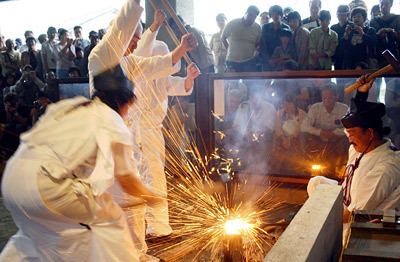Website www.city.seki.gifu.jp | ||
 | ||
Weather 3°C, Wind NW at 14 km/h, 91% Humidity Points of interest Gifuken Hyakunen Park, Nemichi Shrine, Teraogaharasenbonzakura Park, Gifu Prefectural Museum, 21 Seikinomori Park | ||
Seki (関市, Seki-shi) is a city located in Gifu Prefecture, Japan. The city was founded on October 15, 1950.
Contents
- Map of Seki Gifu Prefecture Japan
- History
- Events
- Cuisine
- Universities and colleges
- High schools
- Railroad
- Highways
- References
Map of Seki, Gifu Prefecture, Japan
On February 7, 2005, the towns of Mugegawa and Mugi, and the villages of Horado, Itadori and Kaminoho (all from Mugi District) were merged into Seki.
As of July 2011, the city has an estimated population of 91,239 and a population density of 190 persons per km2. The total area is 472.84 km2.
History
Kinju (金重) - a famous swordsmith. He is also known as Kaneshige using the Japanese pronunciation of his name. He and Kaneuji are founders of the Mino style. Considered to be one of the Juttetsu or "Ten Famous Students" or "10 Great Disciples of Masamune". Moving to Mino Province (today part of Gifu Prefecture) around the time of Ryakuo (1338–1342) creating the Seki tradition.
Enkū (円空) (1632–1695) was a Buddhist monk, poet and sculptor during the early Edo period. He was born in Mino, traveled extensively and died in Seki and is celebrated at the Enkū Museum.
Events
October Cutlery Festival
Cuisine
Seki is today considered the home of modern Japanese kitchen cutlery, where state-of-the-art manufacturing and technology has updated ancient forging skills to produce a world-class series of stainless and laminated steel kitchen knives famed throughout the world. The major cutlery making companies are based in Seki, and they produce the highest quality kitchen knives in the traditional Japanese style and the western style, like the gyuto and the santoku. Knives and swords are so much a part of the city that it is home of the Seki Cutlery Association, the Seki Swordsmith Museum, the Seki Outdoor Knife Show, the October Cutlery Festival, and the Cutlery Hall where tourists can purchase knives.
